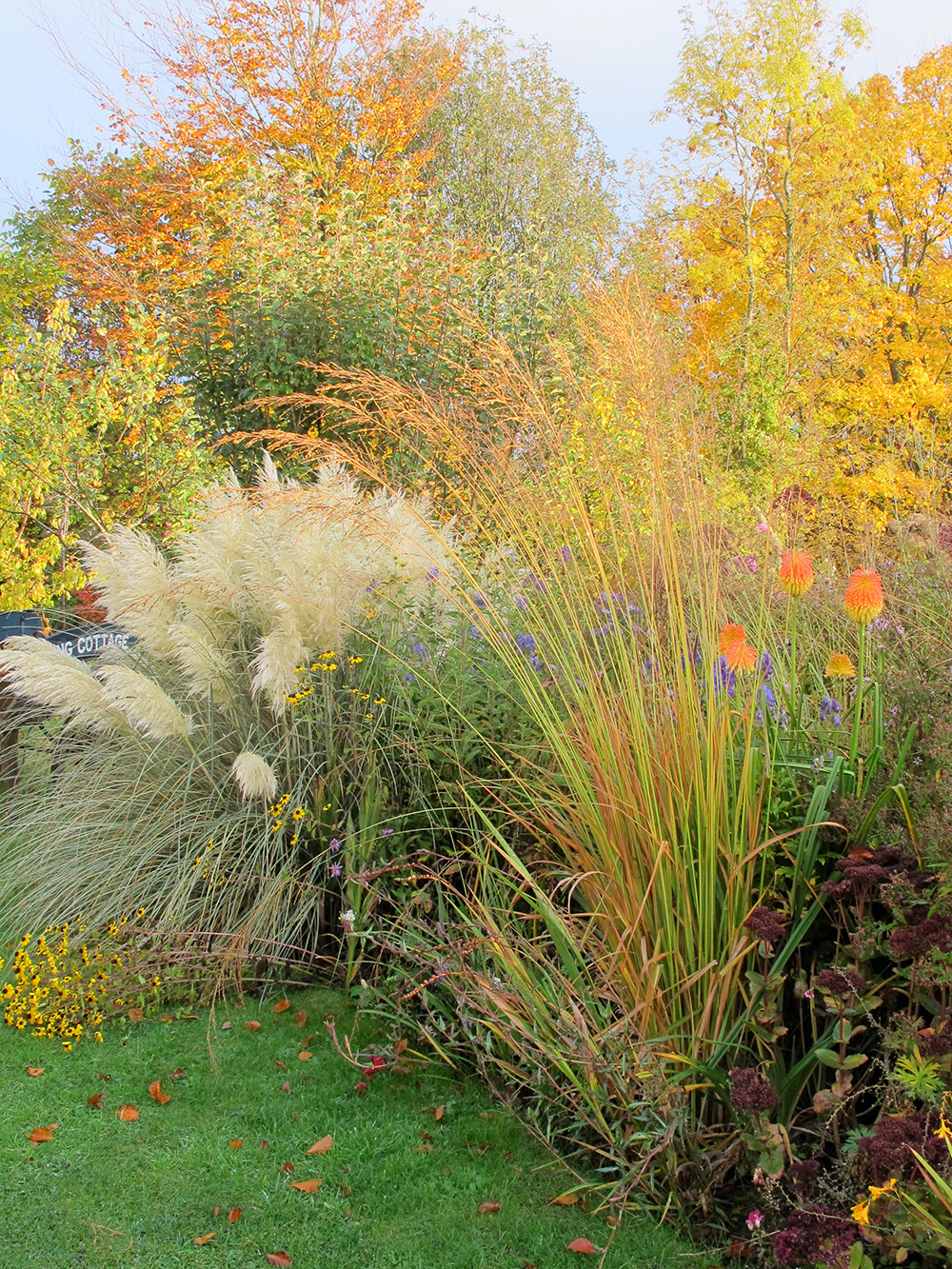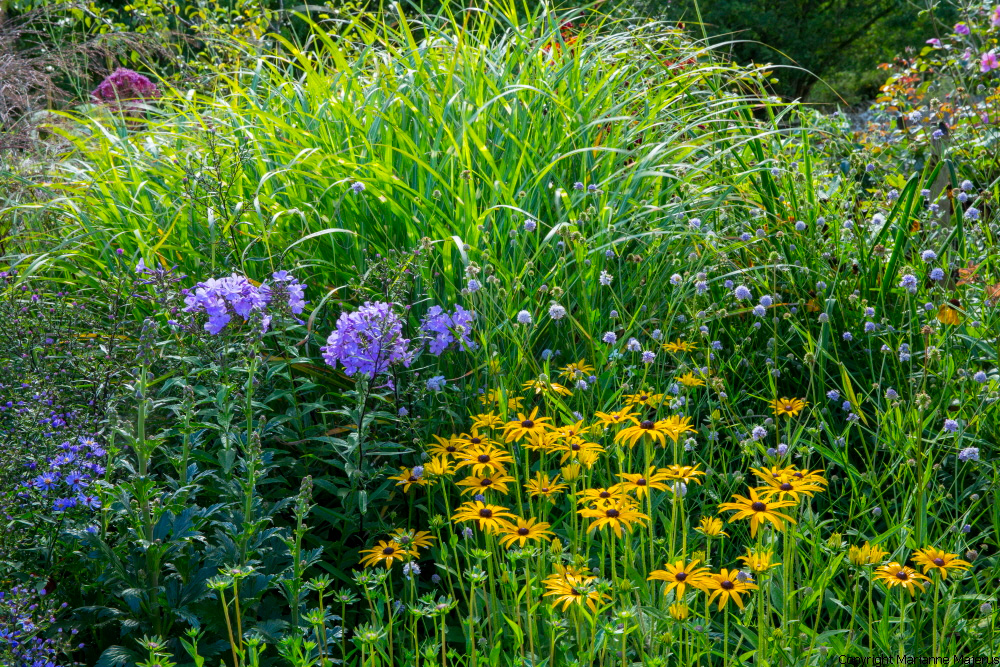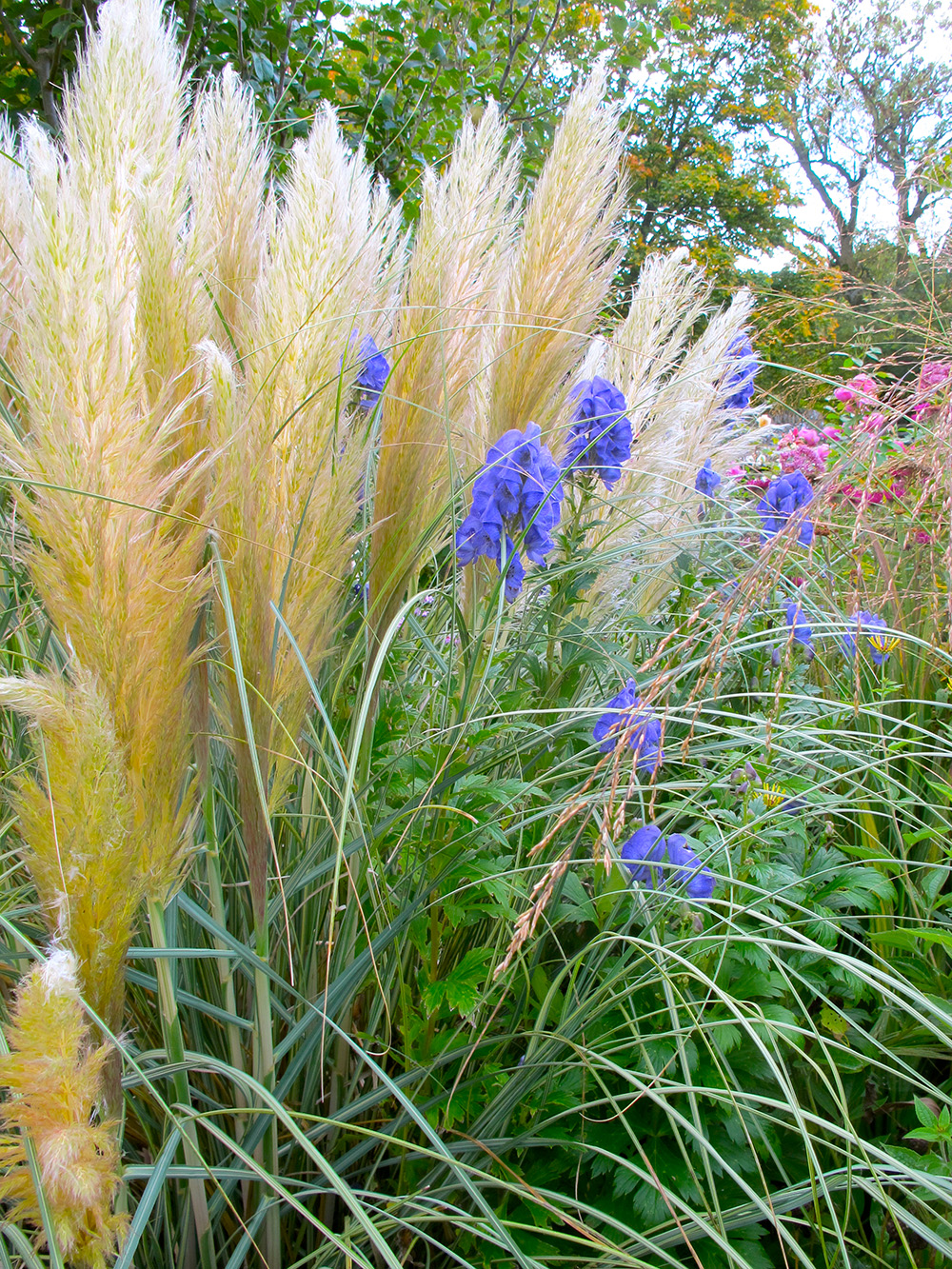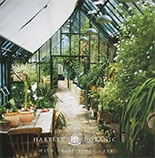I speak to groups of gardeners on a regular basis and, whenever I mention grasses to the audience, there’s a sort of nervous silence, an air of suspicion even. It seems that some gardeners see grasses as a malevolent presence and I can sort of understand why. In the 1970s – yes – I am that old – the only grass widely available was the striped green and white Gardener’s garters, Phalaris arundinacea var. picta. It was a thug. It rampaged through gardens, colonised ponds and crept under fences.

This badly behaved grass, a native of North America, Europe, Asia and North Africa, was capable of growing back from the tiniest snippet of rhizome. However, there are plenty of wonderfully well-behaved grasses that British gardeners could turn to and later season grasses look glorious in October. It’s one of the best months to admire them, because the fluffy flowerheads are backlit by low autumn sunshine and they sparkle like jewels, when autumnal morning dews descend. If the breeze gets up, they shimmy and shake, adding movement and texture to the garden.
King of the late-season grasses is definitely Miscanthus sinensis. Some of our most famous gardeners of old planted this, sometimes for flower and sometimes for foliage. Gertrude Jekyll (1843- 1932), who gardened at Munstead Wood in Surrey, used the horizontally-banded ‘Zebrinus’ to cast light and shade because the green and gold foliage created a sunlit ripple. This is a graceful arching plant, unlike the similar looking ‘Strictus’ which has upright foliage and an erect habit. Of the two, I still prefer ‘Zebrinus’, also known as Zebra grass.
Gertrude Jekyll’s Munstead Wood garden was purchased by The National Trust in April 2023, for its Arts and Crafts Lutyens-designed house and its eleven-acre garden. Restoration is ongoing at the moment and I am SO looking forward to going when it opens. There’s no date as yet. Thirty miles further east her contemporary, William Robinson (1838-1935) of Gravetye Manor, was creating his own romantic wild garden style, an antidote to all the gaudy Victorian bedding he despised.
Robinson loved the feathery flowerheads and dubbed miscanthus the Prince of Wales’s Feathers. Their Latin name at the time, Eulalia japonica, always reminds me of the word Hallelujah and, when I see the first miscanthus plumes, I do say Hallelujah for Eulalai! It’s an established custom, like saluting the magpie. Fail to do so and bad luck might happen that very day. Robinson writes in his classic The English Flower Garden, published in 1889, that ‘as the flowers open these branches curve over gracefully’ and they certainly do.
William Robinson liked grasses and he was the first to grow Pampas grass (Cortaderia selloana) in the UK, having seen it whilst working at Glasnevin in Ireland. When he moved to Regent’s Park in the late 1860s, to replace those horrid bedding plants with enduring hardy perennials, he added it to the borders. Robinson’s Gravetye Manor garden and home still open to the public, if you can afford four-star luxury – which I can’t! Head Gardener, Tom Coward, trained and honed his plant knowledge at Great Dixter in East Sussex and it shows! The garden is superb and so is the accommodation and the food. And the setting is magical. www.gravetyemanor.co.uk Dine or have tea there and you’ll get a great view from the glass-fronted dining room.

We are far luckier than Miss Jekyll or Mr Robinson, because we have far more choice in height, foliage colour and inflorescence. The grass specialist, Knoll gardens, lists forty or so reliably named miscanthus. Visit www.knollgardens.co.uk. These days newly opened plumes can vary from claret-red, to silver to mink-brown, although all fade to shades of beige and ecru as winter bears down. Heights and habit also vary greatly. I rather like ‘Yakushima Dwarf’, a shorter one with lots of caramel-brown cockades, although I don’t have enough room to grow it. I need Miss Jekyll’s acres.
The miscanthus enabler was a German nurseryman named Ernst Pagels (1913 -2007) and the magic ingredient was a heated greenhouse. Pagels used one to persuade one of the earliest flowering cultivars, M. sinensis ‘Gracillimus’, into producing a seed crop in the cool climate of Northern Europe. His first batch of seedlings showed great variation, and subsequent generations produced some stunning cultivars displaying richly coloured flower plumes.
As a young man, Pagels had worked under nurseryman Karl Foerster (1874 – 1970) of Potsdam and Foerster pioneered the use of grasses and named many including Calamagrostis x acutiflora ‘Karl Foerster’. This vertical early season grass is often used as a backbone in prairie planting – although not in my garden. It’s susceptible to wind damage in early summer and I have an exposed garden! The Chicago Botanic Garden say that Foerster discovered it in the 1930s, growing along a railway in Germany. It is reported that he pulled the emergency cord on the train in order to collect the plant. Perhaps he had to pay a fine, but it would have been worth it. Foerster, who trained as a landscape architect, always referred to grasses as nature’s hair. He was the pioneer of natural planting that faded into winter.
His protégé, Ernst Pagels, learnt how to hybridise and select the best. When Pagels left Foerster’s nursery, to set up on his own, he was handed a bag of Salvia nemorosa seeds with the words ‘seek and you shall find’. Pagels went to work and named ‘Ostfriesland’ (East Friesland), after his homeland, ‘Blauhügel’ (Blue Hill), ‘Rügen,’ ‘Wesuwe’ and ‘Tänzerin’. ‘Ostfriesland’ always reminds me of a gas burner, with its hint of red amongst the blue.
Pagels bred many of my favourite plants including Phlomis tuberosa ‘Amazone’, the achilleas ‘Credo’, ‘Terracotta’ and ‘Walter Funcke’, Veronicastrum virginicum ‘Lavendelturm’ and Stachys monnieri ‘Hummelo’. The latter honoured his friend Piet Oudolf but Oudolf’s prairie planting style, always attributed to The Netherlands, began life in Germany. Read more at
https://www.telegraph.co.uk/gardening/gardenprojects/8019864/Dutch-new-perennials-wave.html
I’m a huge admirer of Ernst Pagels, not least because he stayed very active into his late 80s, before passing away aged 92 in 2007. I’m hoping to do the same and so far, so good. One of my great regrets is turning down the chance to visit Pagle’s nursery c. 2000! Friends who went, told me that the entrance was planted up with miscanthus. Why, oh why didn’t I make that trip.
Choosing the right one is important when it comes to Miscanthus sinensis, because it’s on the northern edge of its geographical range in this country. Flowering times vary according to where you live. In the cold Cotswolds my miscanthus don’t produce plumes until late August, although they were earlier this year due to this summer’s heat. Silberfeder’ is also very hardy and I have lost some miscanthus here, including ‘China’. If I was at RHS Wisley, I’d get plumes six weeks earlier likely as not and I wouldn’t lose as many plants as I do, so I like ‘Silberfeder’ because it flowers earlier than the others. This 1950s miscanthus is attributed to Hans Simon and not Pagels. Those in Cornwall aren’t so keen on ‘Silberfeder’ though, because the flowers can break up in winter. Here they last until February, when they’re cut back.

Whenever I see ‘Silberfeder’, I spin back thirty years to Alan Bloom’s Dell Garden in Bressingham, Norfolk. He paired the silver plumes with Aconitum carmichaelii ‘Arendsii’, a rich-blue monkshood. Alan Bloom visited Georg Arend’s Ronsdorf Nursery for the first time in 1952, shortly after his death. One of Georg’s two sons had spent several years on the Ruethe Nursery in Keston in Kent, so Alan was able to converse and they become friends. Arend’s nursery was 800ft above sea level, which always impressed Alan who’d failed to establish a nursery in Canada just after The Second World War, due to the short growing season. Georg’s nursery had been completely destroyed in the Second World War, although there was no resentment apparently.
Alan went on to introduce many of Georg Arend’s plants including lots of astilbes, and the sedum ‘Autumn Joy’, now given its original name of ‘Herbstfreude’. Alan also introduced ‘Silberfeder’ and that stunning rich blue aconitum ‘Arendsii’. Both flourish in my garden, a testament to those great nurserymen and plant raisers. Another Hallelujah’s called for.



